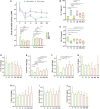Dose of sucrose affects the efficacy of Qiweibaizhu powder on antibiotic-associated diarrhea: Association with intestinal mucosal microbiota, short-chain fatty acids, IL-17, and MUC2
- PMID: 36744095
- PMCID: PMC9893413
- DOI: 10.3389/fmicb.2023.1108398
Dose of sucrose affects the efficacy of Qiweibaizhu powder on antibiotic-associated diarrhea: Association with intestinal mucosal microbiota, short-chain fatty acids, IL-17, and MUC2
Abstract
Introduction: Due to the poor taste of Qiweibaizhu powder (QWBZP), patients have difficulty taking medicine, which leads to poor compliance and limits clinical use to a certain extent. In the trend of restricting sugar intake, sweeteners have gained massive popularity, among which sucrose is a commonly used sweetener in preparations. This study aimed to investigate the effect of different sucrose dose addition with antibiotic-associated diarrhea (AAD) by intervened QWBZP on intestinal mucosal microbiota.
Methods: Thirty specific-pathogen-free (SPF) Kunming (KM) male mice were randomly divided into normal group (N), natural recovery group (M), QWBZP group (Q), low dose sucrose group (LQ), medium dose sucrose group (MQ), and high dose sucrose group (HQ). Subsequently, 16S rRNA amplicon sequencing and GC-MS techniques were used to analyze the intestinal mucosal microbiota and short-chain fatty acid (SCFAs) in intestinal contents, respectively, and enzyme-linked immunosorbent assay was used to determine mucin 2 (MUC2) and interleukin 17 (IL-17).
Results: Compared with the Q group, the results showed that with the increase of sucrose dose, the intestinal microbial structure of mice was significantly altered, and the intestinal microbial diversity was elevated, with the poor restoration of the intestinal biological barrier, decreased content of SCFAs, high expression of inflammatory factor IL-17 and decreased content of mucosal protective factor MUC2. In conclusion, we found that the addition of sucrose had an effect on the efficacy of the AAD intervented by QWBZP, which was less effective than QWBZP, showing a certain dose-response relationship. In this experiment, it was concluded that the addition of sucrose might also further lead to intestinal inflammation and the disruption of the intestinal mucosal barrier, and the production of metabolites SCFAs.
Discussion: The addition of sucrose might also further lead to intestinal inflammation and the disruption of the intestinal mucosal barrier, and the production of metabolites SCFAs. However, these findings still need to be verified in a more extensive study. The effect of adding the sweetener sucrose on the efficacy of Chinese herbal medicine in treating diseases also still needs more research.
Keywords: Qiweibaizhu powder; antibiotic-associated diarrhea; intestinal mucosal microbiota; short-chain fatty acids; sucrose.
Copyright © 2023 Li, Xiao, Deng, Li, Tan and Peng.
Conflict of interest statement
The authors declare that the research was conducted in the absence of any commercial or financial relationships that could be construed as a potential conflict of interest.
Figures








Similar articles
-
Effects of sweeteners on host physiology by intestinal mucosal microbiota: Example-addition sweeteners in Qiweibaizhu Powder on intestinal mucosal microbiota of mice with antibiotic-associated diarrhea.Front Nutr. 2022 Oct 20;9:1038364. doi: 10.3389/fnut.2022.1038364. eCollection 2022. Front Nutr. 2022. PMID: 36337643 Free PMC article.
-
The Effect of Qiweibaizhu Powder Crude Polysaccharide on Antibiotic-Associated Diarrhea Mice Is Associated With Restoring Intestinal Mucosal Bacteria.Front Nutr. 2022 Jul 8;9:952647. doi: 10.3389/fnut.2022.952647. eCollection 2022. Front Nutr. 2022. PMID: 35873450 Free PMC article.
-
Bacterial Characteristics in Intestinal Contents of Antibiotic-Associated Diarrhea Mice Treated with Qiweibaizhu Powder.Med Sci Monit. 2020 May 13;26:e921771. doi: 10.12659/MSM.921771. Med Sci Monit. 2020. PMID: 32398636 Free PMC article.
-
Intestinal mucosal bacterial diversity of antibiotic-associated diarrhea (AAD) mice treated with Debaryomyces hansenii and Qiweibaizhu powder.3 Biotech. 2020 Sep;10(9):392. doi: 10.1007/s13205-020-02383-2. Epub 2020 Aug 16. 3 Biotech. 2020. PMID: 32832342 Free PMC article.
-
Short-chain fatty acids affect the development of inflammatory bowel disease through intestinal barrier, immunology, and microbiota: A promising therapy?J Gastroenterol Hepatol. 2022 Sep;37(9):1710-1718. doi: 10.1111/jgh.15970. Epub 2022 Aug 5. J Gastroenterol Hepatol. 2022. PMID: 35906780 Review.
Cited by
-
TMAO is involved in kidney-yang deficiency syndrome diarrhea by mediating the "gut-kidney axis".Heliyon. 2024 Jul 30;10(15):e35461. doi: 10.1016/j.heliyon.2024.e35461. eCollection 2024 Aug 15. Heliyon. 2024. PMID: 39170478 Free PMC article.
-
Adenine's impact on mice's gut and kidney varies with the dosage administered and relates to intestinal microorganisms and enzyme activities.3 Biotech. 2024 Mar;14(3):88. doi: 10.1007/s13205-024-03959-y. Epub 2024 Feb 22. 3 Biotech. 2024. PMID: 38406640 Free PMC article.
-
Investigating the biological significance of the TCM principle "promoting urination to regulate bowel movements" through the influence of the intestinal microbiota and their metabolites on the renal-intestinal axis.Front Cell Infect Microbiol. 2025 Jan 10;14:1523708. doi: 10.3389/fcimb.2024.1523708. eCollection 2024. Front Cell Infect Microbiol. 2025. PMID: 39867340 Free PMC article. Review.
-
Targeting the Gut-Kidney Axis in Diarrhea with Kidney-Yang Deficiency Syndrome: The Role of Sishen Pills in Regulating TMAO-Mediated Inflammatory Response.Med Sci Monit. 2024 Jun 20;30:e944185. doi: 10.12659/MSM.944185. Med Sci Monit. 2024. PMID: 38898640 Free PMC article.
-
Zhishi Daozhi decoction alleviates constipation induced by a high-fat and high-protein diet via regulating intestinal mucosal microbiota and oxidative stress.Front Microbiol. 2023 Sep 18;14:1214577. doi: 10.3389/fmicb.2023.1214577. eCollection 2023. Front Microbiol. 2023. PMID: 37789856 Free PMC article.
References
LinkOut - more resources
Full Text Sources
Miscellaneous

